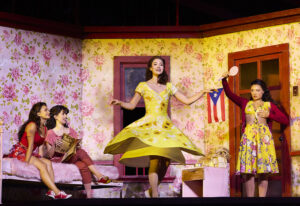Handa Opera on Sydney Harbour, March 22
8.5/104

The sheer jolt of most artistic revolutions fades with time, until, retrospectively, they come to seem more like evolutions. Not West Side Story. Leonard Bernstein packed his score with such shocks and risks – such complex rhythmic syncopations and sudden dissonances – as had never stunned the usually safe and cutesy musical theatre stage before, with some of his most thrilling music coming not in the songs, but in the dance sequences. His music flattered a very simple story with some complexity.
Nonetheless the story was revolutionary in its own way. Romeo and Juliet in 1950s Manhattan, it might have been, but no one killed off the three male leads in this idiom in those days. Musical theatre and musical comedy were interchangeable terms. As Steven Sondheim’s father observed after reading the script and begrudgingly investing in the show, “Not many laughs, are there?”
The one failure of Bernstein, Sondheim (lyrics), Arthur Laurents (book) and Jerome Robbins (direction and choreography) was the glaring simplification of characterisation compared with Shakespeare’s crew. The upshot is that it falls to the lead performers to make something of the archetypes; to make you care.

In that regard, this revival of Francesca Zambello’s Opera Australia production is triumphant. She has prioritised youth, vocal capacity and chemistry in casting Billy Bourchier as Tony and Nina Korbe as Maria, and both more than repay her faith. Their attractive, accurate voices effortlessly convey the requisite emotional weight, without losing a splendid sense of the giddiness of youth. Their celebrated solo and duet numbers – including the arresting Something’s Coming, plus Maria, Tonight and I Feel Pretty, will satisfy the most ardent West Side Story fan.
As will Kimberly Hodgson’s Anita, leading the singing in America (the wit of which, like the zany Gee, Officer Krupke, must have flown over Sondheim’s father’s head). Hodgson also gouges with her nails at what for me is the show’s greatest song: A Boy Like That. Patrick Whitbread (Riff) and Manuel Stark Santos (Bernardo) complete the leads, with Scott Irwin’s Lieutenant Schrank also deserving a mention.

The 40-strong ensemble is excels vocally, and the orchestra under Guy Simpson is as sharp as a flick knife, the rhythm section deserving a special nod. The area in which the production can underwhelm is the dancing, with Kiira Schmidt Carper reviving Robbins’ original choreography. The balletic aspects of the show – most notably in the fight scene – were another facet of the revolution that amazed 1957 audiences. This performance just misses the unison precision required, even though it contains many worthy individual efforts.
The production revels in the vast, on-harbour stage, creating a widescreen effect, and yet with the majority of the audience still close enough to see the faces. The sound quality was mostly brilliantly clear, if sometimes unnecessarily loud, the one misstep being a shrillness to the vocals in America, obscuring Sondheim’s ingenious rhymes.
The design elements more generally are a joy. Brian Thompson’s set includes a motorway overpass that becomes an echo of the Harbour Bridge behind it, dramatically lit by John Rayment. For the Act One dance party, a giant mirror-ball looked alarmingly like a UFO as it was slowly craned into position, and when Doc’s Drug Store was revealed I could swear I even smelt hotdogs.
Issues with the precision of the dancing aside, what’s not to like? Party boats only intruded upon our enjoyment twice and the weather was kind. It’s the perfect answer to the question of where to take a visitor to Sydney.
Until April 21.